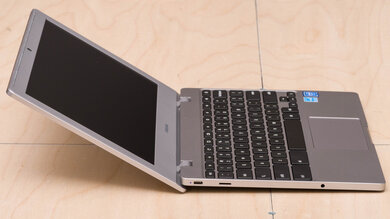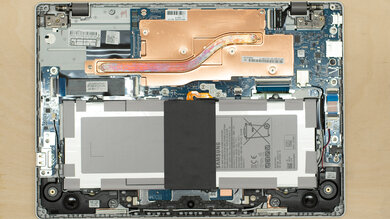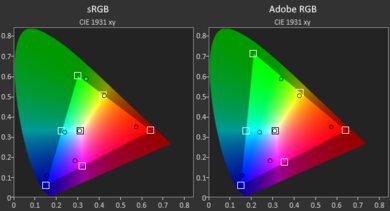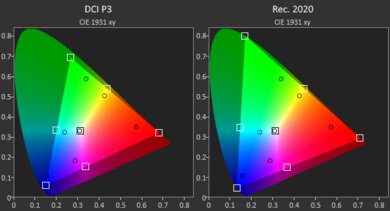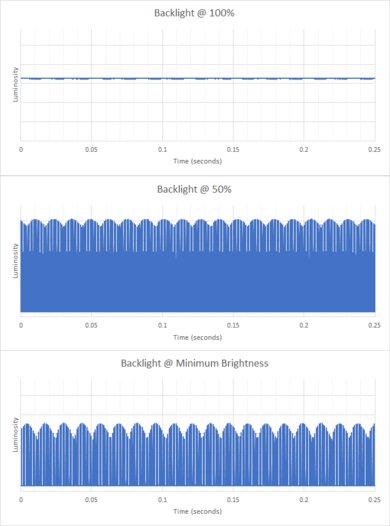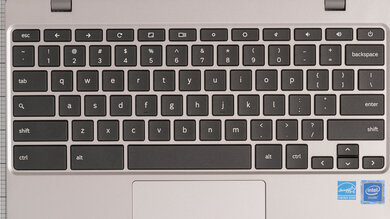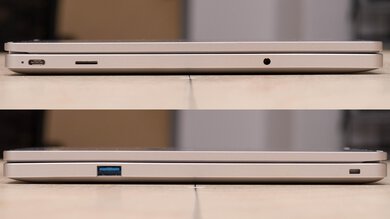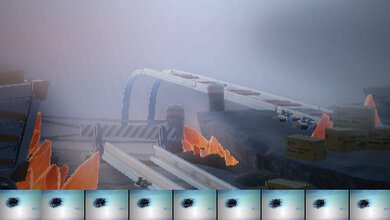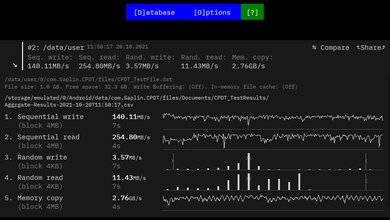The Samsung Chromebook 4 (2019) is a Chrome OS laptop with a good, tough-feeling build. It's remarkably portable, with more than 10 hours of battery life for light productivity tasks and a small and lightweight design. It's completely silent since it's fanless, and the keyboard doesn't get uncomfortably hot even under load. The keyboard feels alright to type on but isn't backlit, the touchpad tracks decently but is a bit small, and there's a decent webcam and microphone for video calls. Also, the speakers sound satisfactory overall, though they don't get very loud. Unfortunately, like most budget Chromebooks, the screen doesn't get very bright, and its poor color gamut makes content look washed out. It also has a disappointing selection of ports, so you'll need to use a dongle or USB hub if you intend to use multiple wired peripherals.
All variants use an 11.6 inch, 720p TN display and an Intel Celeron N4000 CPU with integrated Intel UHD Graphics 600. You can opt for either 4GB or 6GB of RAM and 16, 32, or 64GB of storage. They're all capable of performing light productivity tasks and playing back video without issue, although the laptop will hiccup if you have many tabs open unless you upgrade to 6GB of RAM. None of the models are well-suited for 3D rendering or computational workloads, nor for playing graphically intensive games.
Our Verdict
The Samsung Chromebook 4 is an adequate school laptop. It's outstandingly portable and has a battery that can last more than 10 hours of light productivity. It feels well-built and durable, with a decent webcam and microphone for video conferences or online classes. Unfortunately, its keyboard feels alright to type on but isn't backlit, and although the touchpad tracks decently, it's a bit small. The screen also isn't bright enough to comfortably use in well-lit environments, which can limit the places where you can comfortably work.
- Plastic and metal build feels sturdy.
- Battery lasts through an entire workday of light productivity.
- Outstandingly light and portable.
- Webcam and microphone have decent quality.
- Sub-par, non-backlit keyboard.
- Small touchpad with occasional tracking hiccups.
- Slows down during heavy multitasking.
- Screen doesn't get very bright.
The Samsung Chromebook 4 is bad for gaming. It runs on Chrome OS, so you won't be able to play DirectX games. Also, even though you can run Linux applications in a container, the power-efficient, dual-core Intel Celeron CPU with integrated graphics performs terribly in demanding games. There's only a 60Hz screen option with no support for VRR, and because there aren't any user-replaceable parts, you can't upgrade the memory or storage capacity. We expect you'll only be able to run basic games from the Google Play Store with good performance.
- Stays completely silent, and keyboard doesn't get hot.
- Celeron CPU and integrated graphics perform badly overall.
- Can't run DirectX games.
- Only has a 60Hz refresh rate with no VRR support.
- No replaceable parts.
The Samsung Chromebook 4 is sub-par for media consumption. Its TN screen doesn't get very bright, has a poor contrast ratio, and its narrow color gamut makes content look washed out. It also has poor viewing angles, so you'll need to keep the screen facing you directly for an accurate image. The speakers don't get very loud, but on the bright side, they sound decent overall. The battery lasts through two full feature-length films with charge to spare, and since it's very light and portable, it's easy to hold and carry around.
- Outstandingly light and portable.
- Speakers are satisfactory and have a neutral profile.
- No full sRGB coverage.
- Screen doesn't get very bright.
- Poor viewing angles, with chroma inversion at oblique vertical angles.
The Samsung Chromebook 4 performs poorly as a workstation. You can only get it with a dual-core, low-power Intel Celeron N4000 CPU with integrated Intel UHD Graphics 600, so it isn't suitable for performing tasks like 3D modeling, rendering, or physics simulations. It also uses a slow eMMC drive that makes file transfers and installing large programs take very long. On the bright side, because it's fanless and uses a power-efficient CPU, it stays completely silent and doesn't get very hot.
- Stays completely silent, and keyboard doesn't get hot.
- Awful performance in 3D rendering and similar tasks.
- Can't run x86 applications.
- Poor port selection.
- No replaceable parts.
The Samsung Chromebook 4 is passable for business use. It's remarkably lightweight and portable yet feels well-built and sturdy. The battery lasts through an 8-hour day of light productivity with charge to spare. Unfortunately, although the screen handles reflections very well, its low brightness makes it hard to use in very bright environments. The screen is also small, so it's hard to multitask unless you output to an external display. The keyboard feels alright to type on but can get tiring over long periods, and the port selection is disappointing and very limited.
- Plastic and metal build feels sturdy.
- Battery lasts through an entire workday of light productivity.
- Outstandingly light and portable.
- Webcam and microphone have decent quality.
- Sub-par, non-backlit keyboard.
- Small touchpad with occasional tracking hiccups.
- Slows down during heavy multitasking.
- Poor port selection.
Differences Between Sizes And Variants
We tested the Samsung Chromebook 4 with an 11.6", 720p TN display, an Intel Celeron N4000 CPU, integrated Intel UHD Graphics 600, 6GB of RAM, and 64GB of storage, in the Platinum Titan color scheme. There are no variants with different screen, CPU, or GPU options, but there are a few models with different memory and storage sizes. The variant with 64GB of storage is only available with 6GB of RAM. This laptop is related to the Samsung Chromebook 4+ with a 15.6 inch, 1080p TN display with an extra USB-C port, but to avoid confusion, we consider it a completely different model. You can see the available configurations in the table below.
| Screen |
|
|---|---|
| CPU |
|
| GPU |
|
| Memory |
|
| Storage |
|
| Color |
|
Our display and performance results are only valid for the configuration that we tested. If you come across a different configuration option not listed above, or you have a similar Samsung Chromebook 4 that doesn't correspond to our review, let us know, and we'll update it. Some tests, like black uniformity and color accuracy, may vary between individual units.
You can see our unit's label here.
Popular Laptop Comparisons
The Samsung Chromebook 4 (2019) and the Acer Chromebook 315 (2020) are both Chromebooks that use power-efficient Intel Celeron CPUs. However, the Acer performs better overall, with a larger, crisper touchscreen display, a much better keyboard, and a better webcam and microphone. Also, it has a much better port selection, and its battery lasts far longer. On the other hand, the Samsung is much more portable, and although its speakers don't get as loud, they sound much better.
The Samsung Chromebook 4 (2019) and the Thomson NEO 10 (2020) are both ultraportables with power-efficient CPUs, but the Samsung is a much better laptop for all practical uses. The Samsung feels significantly more responsive thanks to its use of Chrome OS, and it has a far superior battery life. Also, its screen displays more accurate colors, it has a significantly better keyboard and touchpad, and its webcam, microphone, and speakers perform significantly better. On the other hand, the Thomson uses Windows 10, which might be necessary for some people.
The Samsung Chromebook 4 (2019) and the HP Chromebook 14 (2021) are both Chrome OS devices, but the Samsung is an 11-inch ultraportable, whereas the HP is a compact 14-inch laptop. The Samsung is more portable and feels better built, and its webcam and microphone are superior. On the other hand, the HP's keyboard feels much better to type on, its speakers are better, and it has a better selection of ports. It also has a significantly longer battery life.
The Lenovo Chromebook Duet (2020) and the Samsung Chromebook 4 (2019) are both ultraportables with power-efficient CPUs running Chrome OS. The Lenovo has a tablet-like form factor with a kickstand and is better for multimedia viewing, whereas the Samsung has a traditional clamshell design and is better for business use. The Lenovo's IPS display has a much better resolution, gets far brighter, and displays far more accurate colors. On the other hand, the Samsung's keyboard and touchpad feel much better to use, while its speakers, webcam, and microphone are significantly better. It also has more ports.
Test Results

The Samsung Chromebook 4 has a simple design, with a color scheme that Samsung calls "Platinum Titan". The variant with 16GB of storage has a similar, slightly darker scheme called "Satin Gray". The color applies to the bezels and keyboard deck, while the keys are black. It has four rubber feet and down-firing speakers on the bottom. Unfortunately, the bezels are very thick, which can be distracting when using the laptop to watch videos or movies.
The Samsung Chromebook 4 feels well-built. Samsung advertises it as having "military-grade durability"; we found that there isn't very much give when flexing and pushing the device. It feels very tough and well put together, with the keyboard deck and back of the display constructed with thin metal, and the display bezels and bottom are made of plastic. The hinge feels solid and stable.
The Samsung Chromebook 4's hinge is alright. It can't flip back like a 2-in-1, but the range is good and lets you use the laptop in a wide variety of configurations. There's a fair amount of resistance that gives it superb stability, but as a result, it fails the one-finger lift test. The display can be a little wobbly if you type aggressively, but the wobble is fairly minor and shouldn't be an issue for most people.
The Samsung Chromebook 4 is remarkably portable. It can easily slip into a small bag, and since it's light, it shouldn't be a bother to carry around. The charger is also lightweight and compact, meaning you won't have any issues fitting it along with the laptop, even in a small bag.
The Samsung Chromebook 4 has poor serviceability overall. It's very easy to access the internals; you only need to pull back the rubber feet, unscrew 4 Phillips head screws, and pull the cover off, though you might need to use a pick to pry it open. Unfortunately, the only replaceable part is the battery, which you can unscrew and replace. Our unit's heat sink was visibly discolored, but even so, we don't expect it to impact performance. Opening the laptop and making changes to the hardware may void the manufacturer's warranty.
The Samsung Chromebook 4 is available only with a 720p TN display, which doesn't look very sharp, even at this screen size. The bezels are thick and can be distracting when watching content. It's also small, so it isn't the best option if you tend to multitask a lot.
You can only get the Samsung Chromebook 4 with a 60Hz screen, with no support for variable refresh rate technology. However, this is typical of budget Chromebooks. As you can tell from the amount of ghosting in our motion blur photo, the response time is slow, meaning fast-moving content won't look very good.
The Samsung Chromebook 4 has a poor maximum brightness that isn't suitable for use outdoors or in sunny rooms. Fortunately, it gets dim enough for comfortable dark room viewing.
The Samsung Chromebook 4 laptop's matte screen has very good reflection handling and can disperse direct reflections like lamps or television screens directly behind you. However, visibility is still an issue in well-lit environments because the screen doesn't get bright enough to overcome glare.
The Samsung Chromebook 4 has awful black uniformity. It's due mainly to the TN panel's poor viewing angles rather than backlight bleed. You need to be looking at the screen almost perfectly straight on while very close to the panel if you want the best results. Black uniformity may vary between units.
The Samsung Chromebook 4 has disappointing horizontal viewing angles, typical of most TN panels. Looking at the screen from the side, the image has a greenish hue, and dark areas gain an unnatural lightness. It isn't suitable for sharing content with people around you.
The Samsung Chromebook 4 has bad vertical viewing angles that are typical of most TN panels. The image quickly gains a green hue when looking at the screen off-center, and exhibits chroma inversion when viewed at sharp angles from below. If you care about having an accurate image, you'll need to keep the screen facing you directly, which makes it difficult to use the laptop in some situations.
The Samsung Chromebook 4 has an awful color accuracy out of the box, mainly because of its narrow color gamut. Also, it has a very cool color temperature that gives grays a bluish tint. On the bright side, the gamma follows the curve quite nicely, so scenes look well-balanced, although some bright scenes look a little brighter than they are. Color accuracy may vary between units.
The Samsung Chromebook 4's screen displays a poor range of colors. It doesn't have full sRGB coverage, the color space used in standard web content, so photos and videos look washed out. Its narrow color coverage means it isn't suitable for creative professionals working in Adobe RGB, nor for people who want a good HDR experience using the wider DCI P3 or Rec. 2020 color spaces.
The Samsung Chromebook 4 has a sub-par keyboard overall. It's adequately sized, with reasonable spacing between keys, and the keys themselves are fairly stable. Unfortunately, they feel cheap. Typing on it feels alright but is a bit tiring, which can cause strain over long periods. Although the actuation graph shows quite a long travel distance, which some people might not like, it feels as though there isn't enough travel at times. Also, the keys can sound loud, particularly in the lower left side. There isn't any backlighting, which can make it hard to use in the dark.
The Samsung Chromebook 4's touchpad is alright. It feels nice to use, with good tracking, clicking, and palm rejection. However, dragging and dropping can be difficult to perform if you don't keep a uniform pressure across the touchpad's surface, and copy-pasting occasionally gets canceled while you're in the middle of selecting text. The touchpad is also on the small side, so you might run into the edges often if you're scrolling through long spreadsheets or documents.
The Samsung Chromebook 4 has decent speakers. They have a relatively flat overall sound profile which makes content sound neutral, but they lack bass, which is expected of most laptop speakers. There's barely any compression at maximum volume, but with that said, they don't get very loud, to begin with. The bump in the high-mid range and low treble accentuate human speech, making spoken content sound full and clear. However, they fire downwards, which makes content sound muffled.
The Samsung Chromebook 4's webcam and microphone are satisfactory. The colors and the color temperature are true to life, but even though it captures fine details, they aren't necessarily easy to make out. Voices sound loud and clear, but there's a lot of static in the background.
The Samsung Chromebook 4 has an inadequate selection of ports. The laptop's USB-C charging port supports USB 3.2 Gen 1 (up to 5Gbps) and can output a 1440p 144Hz signal to an external monitor. There's only one USB-A 3.2 Gen 1 port, so you need to use a USB hub if you plan to use multiple wired peripherals. Unfortunately, this means that you won't be able to output video to an external monitor while charging unless you use a USB-C monitor with power delivery. There's a spot for a Kensington security lock on the right side.
If you're looking for a similarly sized Chromebook at the same price point but need a dedicated HDMI port, check out the Lenovo 100e Chromebook 2nd Gen (2019).
We couldn't find the model of the Wi-Fi card in the system information or the Terminal. However, the FCC ID printed on the label indicates that the wireless adapter is an Intel Wireless-AC 9560.
The Samsung Chromebook 4 can be equipped with one CPU, the dual-core Intel Celeron N4000, first released in 2017. It's a low-power chip with a base clock of 1.1GHz and a burst frequency of 2.6GHz, which is only a brief boost in performance as opposed to the sustained "Turbo Boost" in more performance-oriented Intel chips. There's no hyperthreading, so the processor can only run two threads at a time, which isn't good for multitasking. However, it's adequate for web browsing and video playback.
You can't equip the Samsung Chromebook 4 with any dedicated graphics cards. There's only the integrated Intel UHD Graphics 600 on the same die as the CPU, which can handle most games from the Google Play Store except graphically intensive ones.
The Samsung Chromebook 4 can be configured with either 4GB or 6GB of LPDDR4 RAM, a variant of DDR4 RAM made specifically for low-power devices. 4GB is enough for casual, everyday use, especially since Chrome OS is so lightweight, but the laptop will feel smoother with 6GB if you tend to have lots of Chrome tabs open or run more demanding games.
The Samsung Chromebook 4 can be configured with either 16, 32, or 64GB of eMMC storage. Both options should be fine if you plan to use cloud storage for photos and videos, but you'll have more space for local apps and games if you opt for 64GB.
The Samsung Chromebook 4 performs badly in Geekbench 5, which is expected of a low-power, dual-core Celeron CPU. Its poor single-thread performance means it's slow in tasks like photo editing and file compression, while its awful multi-thread performance makes it terribly slow when multitasking and editing videos. We couldn't run the GPU compute test on our version of Geekbench 5 because it doesn't support the proper graphics API. That said, we don't expect the Celeron N4000's integrated UHD Graphics 600 to perform well at all in computational workloads.
Cinebench isn't compatible with Chrome OS or Linux.
The Intel Celeron N4000 in the Samsung Chromebook 4 takes more than an hour to render the relatively simple BMW scene in Blender. It isn't suitable for creative professionals or enthusiasts who want to work with 3D models or renders. We used the Linux version of Blender and ran it using a container in Chrome OS. Also, we couldn't run the GPU render test because the Linux version of Blender doesn't support the proper API. That said, we don't expect the integrated graphics to perform any better.
The Samsung Chromebook 4 has awful performance in the Basemark GPU benchmark, which is expected of the integrated graphics in a low-power CPU. It can't run graphically intensive games at high settings, but it can manage decent performance in most games from the Google Play Store.
The Samsung Chromebook 4's eMMC storage performs poorly overall, so it's slow to transfer files to and from the laptop or install large programs. However, thanks to the lightweight nature of Chrome OS, booting the system and launching apps still feel fast.
The Samsung Chromebook 4 has good battery life. You can get through a full school or workday of light productivity with some charge leftover, and you can even make it confidently through two feature-length films with battery to spare. However, battery life varies greatly depending on your usage.
Borderlands 3 isn't compatible with Chrome OS or Linux.
Civilization VI isn't compatible with Chrome OS or Linux.
CS:GO isn't compatible with Chrome OS. Even if you run the Linux version in a container, we don't expect the CPU and integrated graphics to provide a satisfactory gaming experience.
Shadow of the Tomb Raider isn't compatible with Chrome OS. We don't expect the CPU and integrated graphics to provide a satisfactory gaming experience even if you run the Linux version in a container.
The Samsung Chromebook 4 has outstanding thermal and noise performance. It's fanless, so it remains completely silent even under full load, and the keyboard doesn't get very warm.
Cinebench R23 and UNIGINE Heaven aren't compatible with Chrome OS, so we couldn't run any tests to determine if the laptop loses performance over time. Because the CPU has such a low power draw, we don't expect it to throttle significantly under sustained workloads.
The Samsung Chromebook 4 runs Chrome OS, a Linux-based operating system centered around the Google Chrome browser and apps available from the Google Play Store. You can also run Linux apps in a container. However, it isn't compatible with many popular x86 applications like Photoshop. There's no extra software other than what Chrome OS natively comes bundled with.
Every Chromebook has an "expiration date" at which it stops receiving software updates, and according to Google's official document, the end-of-life of the Samsung Chromebook 4 is June 2026. Google may extend this date as they have in the past for other Chromebooks; it's best to check their official document for any changes. For this particular unit, Google states that managed devices with the Chrome Education or Chrome Enterprise Upgrades will continue to receive security and management updates and support, but no new feature updates, until June 2027.



